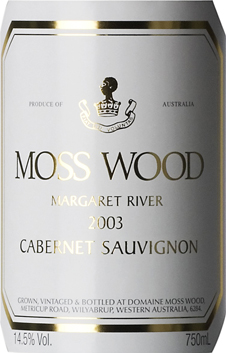Moss Wood 2003 Cabernet Sauvignon
Wine Facts
Blend: Cab Sauv 86%, Cab Franc 6%, Petit Verdot 8%
| Harvested: | 19/3/2003 |
| Bottled: | 29/8/2005 |
| Released: | 6/7/2006 |
| Yield: | 7.47 t/ha |
| Baume: | 13.60 |
| Alcohol: | 14.50% |
| Vintage Rating: | 9/10 |
SOLD OUT
Moss Wood 2003 Cabernet Sauvignon – Gourmet Traveller WINE
100 Top New Releases in the Gourmet Traveller WINE December/January 2007 issue. Moss Wood Cabernet Sauvignon 2003 , Margaret River. Somehow, Moss Wood captures more fleshy smoothness and suppleness than other Margaret River makers. It’s chocolatey and lush in dark-fruit cabernet flavours, while the structure is deep, dense and sumptuous….
Moss Wood Cabernet Sauvignon 2003 – Jenny Tan – The Sunday Times (Singapore)
This old news is good news – Moss Wood Cabernet Sauvignon 2003 Fading fame can be hard to stomach. Take Cabernet Sauvignon in Australia. From the 1960s till the mid-1990s, its reign was assured – it was the king of grapes Down Under and its bombastic, muscular wines were much…
Tasting Notes
The Moss Wood 2003 Cabernet Sauvignon has a deep, youthful brick red colour and is in bright condition. On the nose the primary fruit aromas are typical of Moss Wood Cabernet Sauvignon, showing mulberries, red currants and lifted violets. In the background there are complexities of dark chocolate, coffee bean, earth and cedar.
The palate has generous dark fruit flavours of great length and breadth, combined with the classic Moss Wood balance – richness underpinned by rounded tannins. The finish is a combination of cedar and chocolate notes, combined with charry, spicy oak flavours and more ripe tannins.
Looking back over the history of the vineyard, the team sees a commonality with the 1983 vintage in this wine. The similarities are the warm year and early vintage. Not surprisingly, the young wines were very similar, with ripe, concentrated fruit flavours and tannins. Perhaps the only notable difference between them is the additional complexity resulting from the use of Petit Verdot and Cabernet Franc in the 2003. Those varieties add lively fragrances to the nose and additional length and structure to the palate.
Accordingly, we have very high expectations for this vintage and believe it will give the great 2001 a run for its money in the quality stakes.
Vintage Notes
The growing season in 2003 was one of our best for Cabernet Sauvignon. Conditions were consistently warm right the way through and ensured the fruit ripened nearly two weeks ahead of normal. February in particular provided a succession of warm, indeed hot, days and the fruit charged through to full ripeness. The rate of ripening was further assisted by slightly lower yields, which at 7.47 tonnes per hectare, was down by 3% on the long term average for Cabernet Sauvignon. The number of bunches carried by each vine was average but the weight of these were down because inclement weather during Spring interfered with flowering.
The warm season also ensured that disease pressure was minimal, although Margaret River’s maritime climate means that our temperatures are always very conducive to Powdery Mildew. The 2003 season was no exception but the vineyard crew ensured the disease was kept under control by an effective spray program. Damage caused by birds was minimised using nets.
Amusingly, after a warm and dry summer, the only threat to quality was two rain events. The first occurred when 8mm on the 2nd February and then on the 16th February, a further 18mm fell during thunderstorms. Despite the lateness of this, the Cabernet varieties showed no ill-effects. March remained dry and the Cabernet Sauvignon harvest was finished by 31st March. The Petit Verdot pushed the limits however because it was harvested on 10th April. From the 11th to the 18th, 31mm of rain fell - it just snuck in!
Given that so many things were in our favour for this vintage, it is not surprising that as the samples came and we approached the harvest, the team was enthusiastic about what was in store. And the fruit did not disappoint. The median harvest date for the Cabernet Sauvignon was 26th March and it was picked at an average of 13.7° Baume, contributing 92% of the blend. The Petit Verdot ripeness was 13° Baume and contributed 6%, while the Cabernet Franc was 13.5° Baume and contributed 2%.
Production Notes
In the winery, the technique of production was "Moss Wood traditional". The fruit was destemmed and conveyed into open fermenters and seeded for fermentation with selected yeast strains. Temperatures were maintained at around 30°C and the tanks were plunged 4 times per day for colour and tannin extraction. The wine was left on skins for 10 to 14 days and tasted daily to monitor the progress of the extraction. Each batch was pressed when the best tannin and fruit balance had been achieved.
The wine was then transferred in its various different batches to barrels where it completed malolactic fermentation, after which it was racked, analysed, adjusted and then returned to barrel for the aging process to do its work. All the barriques used to store the wine are French, 55% of them new and predominately from Tonnellerie Remond in Burgundy. There were also components from Taransaud, Rousseau and Bossuet.
At the end of the first year in barrel, the various batches were tasted, the impact of the different oak treatments analysed and noted and then all the different components were blended and the finished wine returned to barrel for the second year of aging.
Towards the end of the second year in wood, various fining trials were carried out to assess the final balance. In particular, the team was conscious of the fact that in lower yielding years, Moss Wood Cabernet Sauvignon can be uncharacteristically tannic and wanted to ensure that this was not the case for the 2003. Interestingly enough, after exhaustive tastings, we concluded that the wine was perfectly fine and didn’t need any adjustment. To finish the process the wine was filtered and bottled in July 2005.
Cellaring Notes
The generosity of youthful flavours makes this vintage a very enjoyable now but, using the development of 1983 as our guide, we recommend this wine be cellared for a minimum of 10 years and it will continue to age well for at least another 10 years beyond that.

